Common Houseplant Pests
It is not just the garden or outdoor plants that get attacked by pests. Houseplants too suffer from pest attacks. Since the indoor environment is predator-free, houseplant pests can reproduce at a much faster rate. This will lead to infestation, creating trouble for you and the entire family. As a house owner, you should always keep a watch on your houseplants. If any of your houseplants looks unhealthy or sick, it is most probably because of bugs or pests.
But do you know the symptoms of pest attacks? Can you identify some of the most common houseplant pests?
There are multiple types of pests or bugs that attack indoor plants. Some of these are more common than others. If you want to avoid severe infestation, you should keep an eye out for the signs of pests. Provided you identify pest attacks in time, you can take the necessary measures to control them.
The Most Common Pests
Houseplants can come under attack from a variety of pests. Given below is a list of the most common ones. Read on to know more about houseplant bugs and pests as well as their identifying symptoms. Also, find out what kind of treatments methods you can use to get rid of the plant bugs.
Aphids:
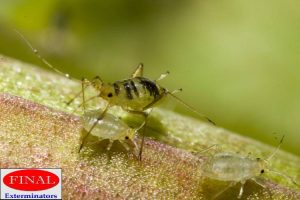
Also referred to as greenfly or blackfly, aphids are one of the most common pests that attack houseplants. Usually, these sap-sucking bugs attack the soft areas of a plant. To see them, you need to give the affected houseplant a closer look. They remain hidden under the leaves. Though these bugs are typically green in color, they can also be grey or black.
Symptoms:
Initially, the number of aphids is small. But, they multiply rapidly and can soon form colonies. Aphids and some scale bugs secrete a sugar-rich sticky liquid, called honeydew. When examining an indoor plant for these bugs, you should look for sticky honeydew deposits. Another key sign to identify these pests is husk-littered soil. Husks can also be found sticking to the honeydew. These pest attacks can also create yellow patches in the plant.
Treatment:
Depending on the severity of the infestation, you can either use a chemical spray or get rid of the bugs with the use of warm soapy water. If the quantity of aphids is not large, you can prepare a solution with soap and warm water. Use a spray bottle to apply the mixture to the affected areas of the plan. Target the aphids in particular. Give the mixture five minutes to do its job and then wash it off. If the infestation is too much for you to handle, get in touch with a pest removal service in your area. Pest control experts will offer the best solution.
Red Spider Mites:
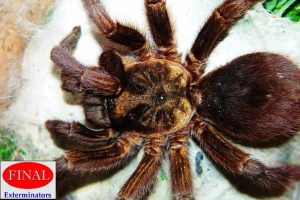
These arachnids suck the liquid from plant leaves. They do not feed on flies like other spiders. They spin webs all around the houseplant in a bid to keep their colonies safe. If you are squeamish about bugs, you may find it difficult to get rid of these plant bugs yourself.
Symptoms:
The webbing is all around for you to see. So, you can easily find out if your indoor plant is under attack. Additionally, you can look for little brown dots on the leaves of the plant. Red spider mites suck the sap of the leaves. They do so by inserting their mouthparts in the leaf cells. When the sucked cells are not alive, they become brown and hence you see those brown dots.
Treatment:
There are many ways to remove red spider mites from a houseplant. The simplest of them is to give your plant a shower with lukewarm water. Repeating this exercise a couple of times every week will free the plant from all the webbing as well as the pests. There are some chemical products, which can be used to get rid of the red spider mites. For more information on the removal of pests, it is a good idea to get in touch with a professional exterminator.
Scale Pests:
These insects feed on the liquid or sap found in plants. Scale bugs remain attached to different parts of a plant. Warm and dry conditions enable the growth of these pests. The bodies of these houseplant pests remain covered and protected inside shell-like layers. It can be difficult to spot them because they are smartly camouflaged. You’ll think they are just natural blemishes.
Symptoms:
You won’t be able to identify these houseplant pests unless you really give a closer look. If a plan is affected by these bugs, the plant will have sugary honeydew all over it. Particularly, you should look under the leaves. The shape of these pests is small and round and their color is brown.
Treatment:
A house plant infested with scale pests isn’t easy to clean. The task of pest removal becomes difficult because of the protective, waxy covering that these pests hide within. Their offspring are almost invisible to the untrained eye. If you plan to get rid of these bugs, you should do it in several steps. First, you need to spray a mixture of soap and water on the plant. Leave the mixture for a few minutes so that it softens the shell-like covering. Once the discs have been softened, you need to give your plan a final wash and remove the pests. You can also use alcohol and other products to perform this pest removal task.
 Get Started Now. Give us a call at(800) 953 1397
Get Started Now. Give us a call at(800) 953 1397Mealybugs:
These sap-sucking bugs are common on indoor plants. They resemble like white masses of cotton and grow in warm conditions. At the first look, you’ll mistake these white bugs for cotton wool. They suck out the liquid out of plants using their long mouthparts. When the infestation is at a lower level, mealybugs don’t cause much harm to the plant. But when this is left untreated for a long time, these bugs can take away the strength and damage the plant.
Symptoms:
Look under the side of the leaves and at the left joints. It is not difficult to spot these white bugs on plants. Since they live in colonies, you can easily identify if your houseplant has these pests. Usually, these bugs cause the plant to dehydrate and the plant also starts to lose leaves.
Treatment:
If the mealybugs have just made their way to your indoor plant, they can be removed easily and quickly. All you need to do is to shake the plant and spray it with water. If it is only a couple of affected branches, you can simply cut those branches off. To get rid of severe infestation, you may need to use some specific products. For best advice, talk to a pest control expert.
Fungus Gnat:
Once these annoying pests start distracting you constantly, you’ll want to know how they entered your house. On doing some inspection, you may find that they are coming from the indoor plants. These houseplant pests grow quickly in humid climate conditions. These pests cause damage to the roots of plants when they are in the larval stage. If your houseplant is under attack from these pests, you need to find them and destroy their entire colony.
Symptoms:
Small black flies are always easy to spot. You can find them flying around in the house or near the window. It is difficult to spot the larva of these pests, as they are very small and live below the soil.
Treatment:
Closely examine the houseplant, particularly close to the soil surface. If you turn up some soil close to the base of the plant, you’ll be able to see the larvae of the fungus gnats. If the soil remains damp most of the time, the larva will thrive and the population of the pest will increase. So, avoid overwatering and try to keep the soil surface dry till there are no more pests. There are many pesticides and insecticides that you can also use to get rid of these pests.
Springtails:
These white or grey houseplant pests live in the soil. Although springtails don’t cause damage to a houseplant, their jumping and running can make you feel squeamish. They start to move wildly when you put water in the soil. Their mass existence can become frustrating.
Symptoms:
Springtails are small, white insects. They eat the decaying material in the soil. You can spot them at the first glance.
Treatment:
Springtails survive in moist and humid conditions. If you notice the presence of these white bugs, you should try to keep the soil less moist. If you keep it dry or less moist, these pests won’t be able to live for too long. However, using this method can be tricky. In order to get rid of springtails, you shouldn’t starve your plant of water. So, remember to exercise some caution.
Leafminers:
Usually, these pests attack outdoor plants. However, they can also affect indoor plants. Leafminers are in the larva stage, known as maggots. These maggots feed on the parts that remain between the upper and the lower surfaces of leaves. Small black flies lay eggs on the leaves. The larva starts to feed on the middle portion of the leaves – until they grow up.
Symptoms:
If squiggly lines have appeared through the leaves of your houseplant, this means this is an attack from leafminers. Minor outbreaks are easy to control. For high level infestations, you’ll need to use insecticides. There are both natural ways as well as pesticides and insecticides to get rid of leafminers. You should apply a solution which fits in with your specific problem.
How to Prevent Houseplant Pest Infestations
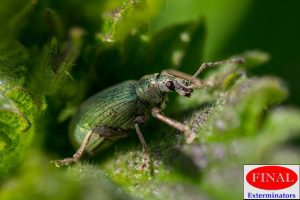
Don’t forget: Prevention is better than cure. There are some simple steps that you should follow to keep out pests and bugs.
Homeowners often buy new plants. It is crucial to give the new plant a proper inspection to make sure it is free from pests and bugs. Key areas where you should look for signs of common pests include the undersides of leaves and the stems. It is advisable to examine the soil as well.
It is a good idea to keep a new plant in a separate place for a few weeks. If the plant contains some larva or pests that you were unable to notice, putting it in isolation will give you time to find out if it is under attack. Before moving the houseplant indoors, you should spray it in all key areas. Also, make it a routine to inspect all your indoor plants on a weekly basis for signs of pests. If your plants show symptoms, take appropriate measures to control pests quickly.
Talk to a Professional Exterminator Now!
If you have more questions in regard to common houseplant pests or want expert help for pest control, feel free to reach out to Final Exterminators. We offer a full range of pest and termite control services in and around Moreno Valley, CA. Give us a quick call for a FREE pest control consultation.

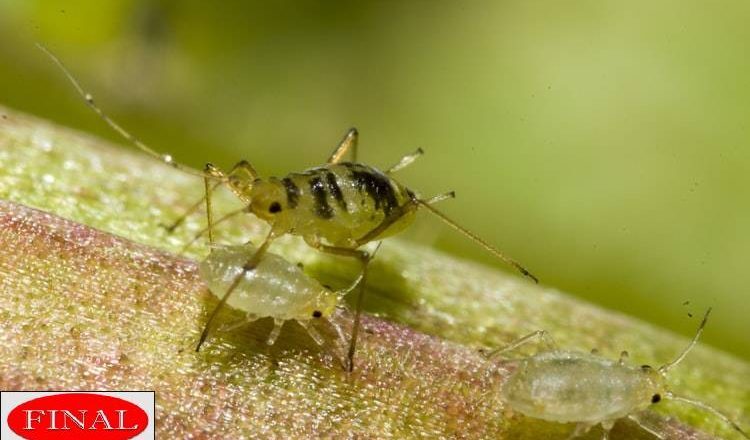

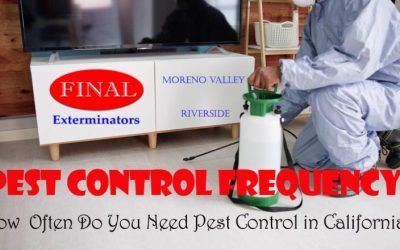
0 Comments